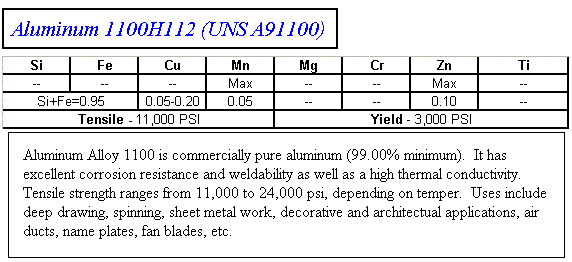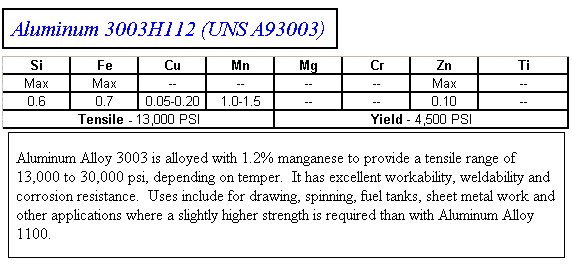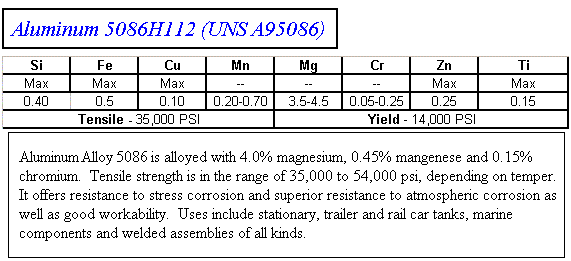|
Aluminum Alloy Designations
The aluminum industry uses a four-digit index system for the designation of its wrought aluminum alloys.
As outlined below, the first digit indicates the alloy group according to the major alloying element.
1xxx Series
In this group, the minimum aluminum content is 99% and there is no major alloying element.
The second digit indicates modifications in impurity limits. If the second digit is zero, there is no special control on individual impurities. Digits 1 through 9, which are assigned consecutively as needed, indicate special control of one or more individual impurities.
The last two digits indicate the specific minimum aluminum content. Although the absolute minimum aluminum content in the group is 99%, the minimum for certain grades is higher than 99%, and the last two digits represent the hundredths of a per cent over 99%. In this senario, Grade 1030 would indicate 99.30% aluminum, without special control on the individual impurities. Grades 1130, 1230, 1330, etc., indicate the same purity with special control on one or more impurities. Likewise, 1100 indicates minimum aluminum content of 99.00% with individual impurity control.
2xxx through 9xxx Series
The major alloying elements are indicated by the first digit, as noted:
2xxx.....Copper
3xxx.....Manganese
4xxx.....Silicon
5xxx.....Magnesium
6xxx.....Magnesium and Silicon
7xxx.....Zinc
8xxx.....Other Element
9xxx.....Unused at this point in time
The second digit indicates alloy modification. If the second digit is zero, it indicates the original ally; digits 1 through 9, which are assigned consecutively, indicate alloy modifications. The last two digits have no special significance, serving only to identify the different alloys in the group.
Aluminum Temper Designations
The temper designation system used for all forms, except ingots of aluminum and its alloys, are based on the sequence of basic treatments used to produce various tempers. The basic temper designation consists of a letter and subdivisions of the basic temper are indicated by one or more digits following the letter.
Basic Temper Designations
F.....As Fabricated
O.....Annealed
H.....Strain Hardened
W.....Solution Heat Treated
T.....Thermally Treated - to produce a stable temper other than those listed
Subdivision of H Temper
H1.....Strain Hardened Only
H2.....Strain Hardened, then partially annealed
H3.....Strain Hardened, then stabalized
The degree of strain hardening is indicated by a second digit following one of the above designations:
2.....1/4 hard (tensile strength midway between 0 and 4)
4.....1/2 hard (tensile strength midway between 0 and 8)
6.....3/4 hard (tensile strength midway between 4 and 8)
8.....full hard (tensile strength achieved by 75% cold reduction after anneal)
9.....extra hard (minimum tensile 2.0ksi higher than 8)
A third digit may be used to indicate a variation of a two digit number.
Subdivision of T Temper
T1.....Cooled from an elevated temperature shaping process and naturally aged
T2.....Annealed
T3.....Solution heat treated and cold worked
T4.....Solution heat treated and naturally aged
T5.....Cooled from an elevated temperature shaping process and artificially aged
T6.....Solution heat treated and artificially aged
T7.....Solution heat treated and stabilized
T8.....Solution heat treated, cold worked and artificially aged
T9.....Solution heat treated, artificially aged and cold worked
T10....Cooled from an elevated temperature shaping process, artificially aged and cold worked
Additional digits are used to designate stress relieving:
T51....Stress relieving by streching
T52....Stress relieving by compressing
|













